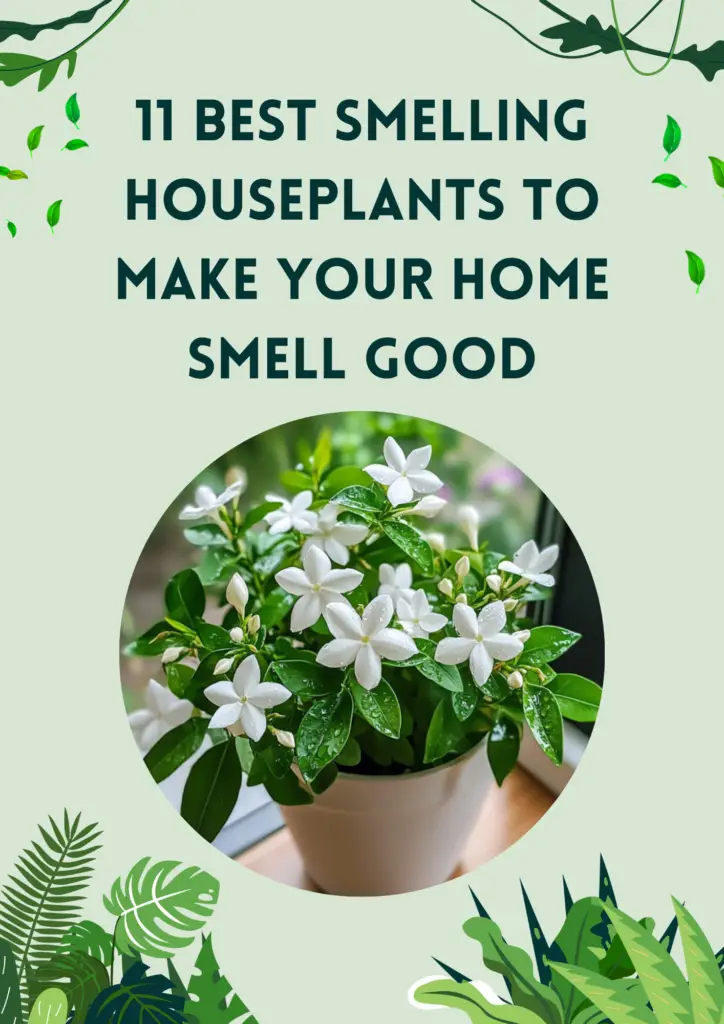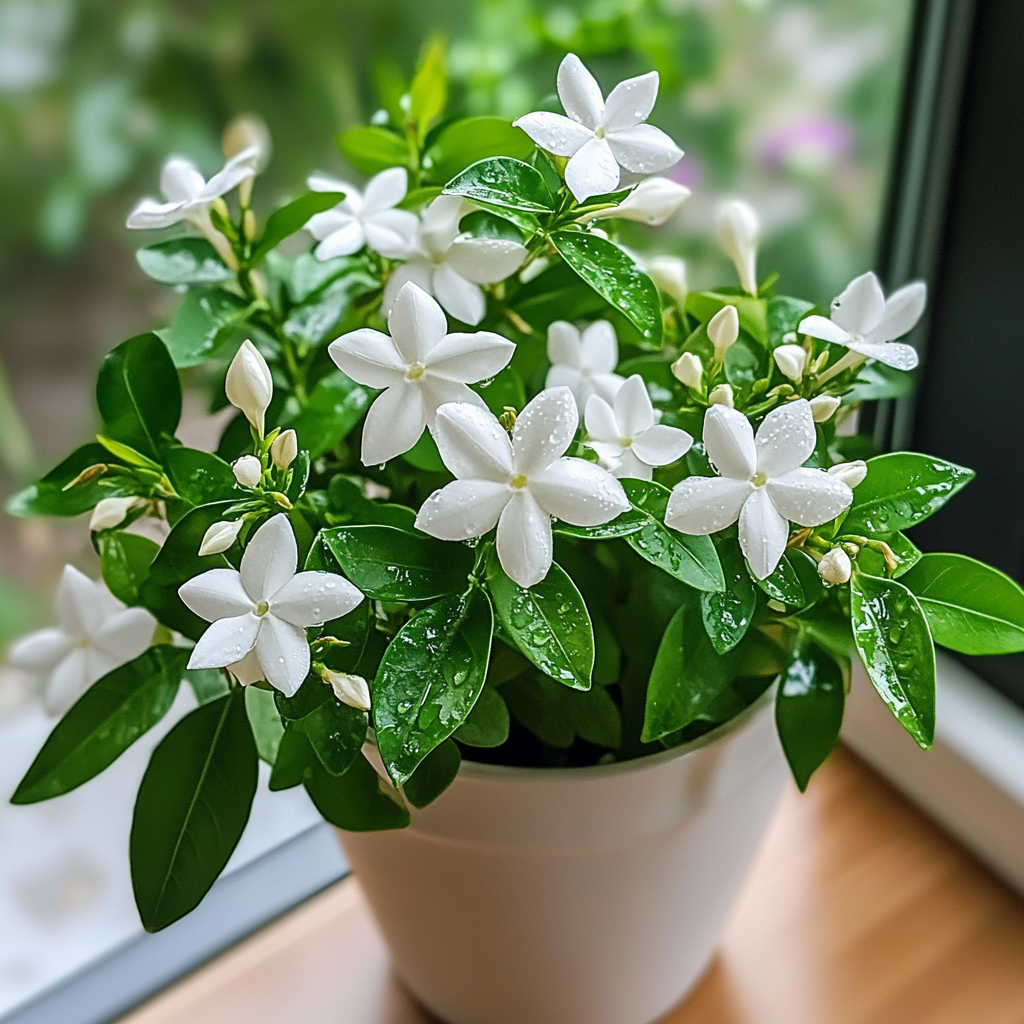Looking for plants that will enhance your home’s aroma? Here’s a list of the 11 best smelling houseplants to bring pleasant, natural fragrances into your living space.
Houseplants do more than just purify the air and beautify your home. Certain varieties can also release delightful fragrances that transform your home into a sanctuary. In this article, we explore the 11 best smelling houseplants that not only look good but smell fantastic too. Whether you’re into subtle floral scents or a more intense, refreshing fragrance, there’s something on this list for every home.
1. Jasmine: A Sweet, Romantic Aroma
One of the most fragrant houseplants, jasmine (Jasminum spp.), is renowned for its sweet, intoxicating scent. It’s often associated with romance and tranquility, making it perfect for bedrooms or living rooms. Jasmine flowers bloom in clusters, emitting a fragrance that’s both fresh and floral.

Jasmine thrives in bright, indirect light, so be sure to place it in a location where it can get sufficient light but not too much direct sun. This plant also enjoys slightly warmer temperatures and will reward you with its lovely fragrance if taken care of properly.
External Link Recommendations:
- Jasmine Plant Care Tips from The Spruce
- How to Grow Jasmine: A Complete Guide from Gardening Know How
2. Gardenia: A Fragrance That’s Simply Irresistible
Gardenia (Gardenia jasminoides) is another favorite among houseplant lovers for its striking beauty and strong scent. This plant produces creamy-white flowers that give off an unforgettable, sweet fragrance. The smell is rich and floral, making it perfect for adding a luxurious touch to any room.
Gardenias thrive in humid conditions, so placing them in bathrooms or kitchens works well. They also need bright, indirect light and should be watered regularly.
3. Lavender: Calming and Refreshing
Lavender (Lavandula angustifolia) is a fragrant plant known for its calming and soothing properties. The beautiful purple flowers release a delicate, aromatic scent that promotes relaxation, making it ideal for bedrooms or meditation spaces. Lavender is perfect for those who want both a pleasing scent and a low-maintenance plant.
Lavender does best in a sunny spot with well-drained soil. It’s also drought-tolerant, so it’s a great option for those who tend to forget watering plants occasionally.
External Link Recommendations:
- Growing Lavender Indoors: Tips and Tricks from Better Homes & Gardens
- Lavender Plant Care Guide from The Old Farmer’s Almanac
4. Eucalyptus: A Refreshing, Clean Scent
Eucalyptus (Eucalyptus spp.) is a popular plant known for its invigorating, fresh scent. The leaves contain essential oils that provide a cool, crisp aroma, making it ideal for kitchens or entryways. This plant is also known for its air-purifying properties.
Although eucalyptus grows tall in the wild, indoor varieties can be kept compact with regular pruning. Eucalyptus thrives in bright, indirect light and benefits from occasional misting to maintain humidity.
5. Rose: Classic and Fragrant
The scent of roses (Rosa spp.) is synonymous with romance, and many people associate roses with beauty and love. Indoor rose varieties, especially miniature ones, can be grown as houseplants to add a touch of elegance and fragrance to any room.
Roses need plenty of sunlight, ideally 6-8 hours a day, and should be watered deeply but infrequently. They also benefit from occasional fertilizing to keep the blooms vibrant and plentiful.
6. Lemon Balm: A Zesty, Citrusy Fragrance
If you’re looking for a plant that offers a fresh, uplifting scent, lemon balm (Melissa officinalis) is an excellent choice. Its citrusy aroma can bring a refreshing atmosphere to your home, and the leaves can be used for making herbal teas or adding a zesty flavor to dishes.
Lemon balm prefers partial to full sunlight and well-drained soil. It’s relatively low-maintenance, making it perfect for beginners or those with limited time to dedicate to plant care.
7. Scented Geraniums: Variety in Fragrance
Scented geraniums (Pelargonium spp.) are well-known for their fragrant leaves, which come in a variety of scents such as rose, lemon, and mint. These plants can add a burst of aroma to your home without being overpowering. Their flowers are also attractive, providing both beauty and fragrance.
Place your scented geraniums in a location with bright sunlight and allow the soil to dry out slightly between waterings. These plants thrive with a little extra care and attention.
8. Orchids: Elegant with a Soft Fragrance
While not all orchids (Orchidaceae) are fragrant, many varieties offer a light, sweet scent. Orchids are often seen as luxurious and elegant, making them an ideal choice for homes that need a touch of sophistication.
Caring for orchids requires attention to humidity levels, bright indirect light, and periodic watering. When well-cared for, orchids will reward you with both stunning flowers and a gentle fragrance that fills the room.
External Link Recommendations:
9. Mint: A Refreshing, Invigorating Scent
Mint (Mentha spp.) is a herb known for its cooling, refreshing scent. Growing mint indoors can give your home an instant burst of freshness, and it’s easy to grow in containers on windowsills or kitchen counters. Plus, mint leaves can be used for cooking or in drinks, providing a multi-purpose benefit.
Mint prefers moist soil and bright, indirect light. It’s a relatively hardy plant, but it can spread quickly, so it’s best to contain it in a pot to avoid overcrowding other plants.
10. Lemon Grass: A Tropical, Citrusy Scent
Lemon grass (Cymbopogon citratus) offers a light, citrusy fragrance that’s perfect for brightening up any room. This tropical plant thrives indoors, making it a fantastic addition to your collection. It also adds a refreshing aroma that can help promote a calming, peaceful environment.
Lemon grass prefers full sun and well-drained soil. Keep it watered, but make sure the soil doesn’t become too soggy to avoid root rot.
11. Sweet Alyssum: A Sweet Floral Fragrance
Sweet alyssum (Lobularia maritima) is a fragrant plant with small, delicate flowers that emit a sweet, honey-like aroma. It’s perfect for windowsills or hanging baskets and attracts pollinators such as bees. Despite its small size, this plant is incredibly fragrant and can fill your home with its light, sweet scent.
Sweet alyssum thrives in full sun and well-drained soil. It’s best to water it regularly but allow the soil to dry out slightly between waterings.
Conclusion: Transform Your Home with These Amazing Smelling Houseplants
Bringing the 11 best smelling houseplants into your home can elevate your living space, not only by purifying the air but also by infusing it with delightful aromas. Whether you’re drawn to floral fragrances like jasmine and roses, fresh scents like eucalyptus and lavender, or zesty varieties like lemon balm, there’s a plant for every preference.
Integrating houseplants into your décor offers both aesthetic and sensory benefits. With proper care, these plants can provide a continuous source of fragrance and beauty in your home.
Frequently Asked Questions (FAQs)
What plants make your house smell good?
Plants like jasmine, lavender, and eucalyptus are among the best options for making your house smell good. Their natural fragrances can fill your home with delightful scents.
Which indoor plant gives a good smell?
Gardenias, orchids, and scented geraniums are excellent indoor plants that release pleasant fragrances into your home.
Do houseplants make your house smell?
Yes, many houseplants emit natural scents that can enhance the aroma of your home. Plants like lavender, jasmine, and mint are perfect for this purpose.
What makes your house always smell good?
To keep your home smelling fresh, opt for plants like eucalyptus, lemon balm, and sweet alyssum. Regularly caring for these plants ensures they continue releasing delightful fragrances.
Suggested Articles:
- How to Care for Indoor Plants
- The Best Low-Maintenance Houseplants for Beginners
- 10 Easy Herbs to Grow Indoors
For more interesting tips you can see here www.sotastyrecipe.com/tips
And for recipes lovers, you can check my friend’s blog here www.infloin.com
